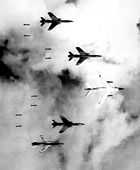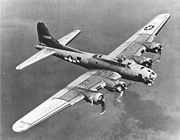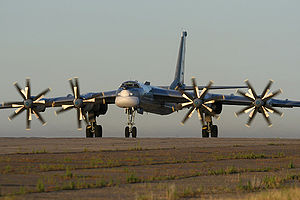
Level bomber
Encyclopedia

Aerial bomb
An aerial bomb is a type of explosive weapon intended to travel through the air with predictable trajectories, usually designed to be dropped from an aircraft...
s while in high altitude. The term is used as a counterpart to both World War II
World War II
World War II, or the Second World War , was a global conflict lasting from 1939 to 1945, involving most of the world's nations—including all of the great powers—eventually forming two opposing military alliances: the Allies and the Axis...
dive bombing and low-level bombing. Before the age of precision guided munitions (PGMs), it was mostly used for strategic bombing
Strategic bombing
Strategic bombing is a military strategy used in a total war with the goal of defeating an enemy nation-state by destroying its economic ability and public will to wage war rather than destroying its land or naval forces...
, in other words to damage enemy's economy and population, not for attacking specific military targets. While there exist purposely designed high level bomber
Bomber
A bomber is a military aircraft designed to attack ground and sea targets, by dropping bombs on them, or – in recent years – by launching cruise missiles at them.-Classifications of bombers:...
s, these missions can be also flown by more general aircraft, such as fighter-bomber
Fighter-bomber
A fighter-bomber is a fixed-wing aircraft with an intended primary role of light tactical bombing and also incorporating certain performance characteristics of a fighter aircraft. This term, although still used, has less significance since the introduction of rockets and guided missiles into aerial...
s.
World War II

Allies of World War II
The Allies of World War II were the countries that opposed the Axis powers during the Second World War . Former Axis states contributing to the Allied victory are not considered Allied states...
for carpet bombing
Carpet bombing
Carpet bombing is a large aerial bombing done in a progressive manner to inflict damage in every part of a selected area of land. The phrase invokes the image of explosions completely covering an area, in the same way that a carpet covers a floor. Carpet bombing is usually achieved by dropping many...
(particularly later in the war), such as the bombing of Dresden
Bombing of Dresden in World War II
The Bombing of Dresden was a military bombing by the British Royal Air Force and the United States Army Air Force and as part of the Allied forces between 13 February and 15 February 1945 in the Second World War...
or Tokyo. They were also deployed in other kinds of missions such as Operation Tidal Wave, Operation Crossbow
Operation Crossbow
Crossbow was the code name of the World War II campaign of Anglo-American "operations against all phases of the German long-range weapons programme—operations against research and development of the weapons, their manufacture, transportation and their launching sites, and against missiles in flight"...
, and the sinking of the Tirpitz
Operation Catechism
Operation Catechism was the last of nine attempts to sink or sabotage the Kriegsmarine battleship Tirpitz during World War II. On November 12, 1944, the RAF Bomber Command dispatched 30 Avro Lancaster heavy bombers from No. 9 Squadron RAF and No. 617 Squadron RAF Operation Catechism was the last of...
.
After initial operations by day suffered heavy losses, the British switched to night-time sortie
Sortie
Sortie is a term for deployment or dispatch of one military unit, be it an aircraft, ship, or troops from a strongpoint. The sortie, whether by one or more aircraft or vessels, usually has a specific mission....
s where the darkness gave some protection against German fighters. Arthur "Bomber" Harris
Sir Arthur Harris, 1st Baronet
Marshal of the Royal Air Force Sir Arthur Travers Harris, 1st Baronet GCB OBE AFC , commonly known as "Bomber" Harris by the press, and often within the RAF as "Butcher" Harris, was Air Officer Commanding-in-Chief of RAF Bomber Command during the latter half of World War...
's strategy for the RAF Bomber Command
RAF Bomber Command
RAF Bomber Command controlled the RAF's bomber forces from 1936 to 1968. During World War II the command destroyed a significant proportion of Nazi Germany's industries and many German cities, and in the 1960s stood at the peak of its postwar military power with the V bombers and a supplemental...
was to attack area targets that the bombers could be more certain of hitting at night, while the U.S.
United States
The United States of America is a federal constitutional republic comprising fifty states and a federal district...
preferred daylight, precision bombing
Precision bombing
Precision bombing is bombing of a small target with extreme accuracy, to limit side-effect damage. An example would be destroying a single building in a built up area causing minimal damage to the surroundings...
techniques. The development since the 1930s of gyroscope
Gyroscope
A gyroscope is a device for measuring or maintaining orientation, based on the principles of angular momentum. In essence, a mechanical gyroscope is a spinning wheel or disk whose axle is free to take any orientation...
-stabilised bombsight
Bombsight
A bombsight is a device used by bomber aircraft to accurately drop bombs. In order to do this, the bombsight has to estimate the path the bomb will take after release from the aircraft. The two primary forces during its fall are gravity and air drag, which makes the path of the bomb through the air...
s, such as the Norden bombsight
Norden bombsight
The Norden bombsight was a tachometric bombsight used by the United States Army Air Forces and the United States Navy during World War II, and the United States Air Force in the Korean and the Vietnam Wars to aid the crew of bomber aircraft in dropping bombs accurately...
, also helped the Allied air forces' ability to accurately strike their targets with medium- to high-altitude
Altitude
Altitude or height is defined based on the context in which it is used . As a general definition, altitude is a distance measurement, usually in the vertical or "up" direction, between a reference datum and a point or object. The reference datum also often varies according to the context...
level bombing attacks.
Nazi Germany
Nazi Germany
Nazi Germany , also known as the Third Reich , but officially called German Reich from 1933 to 1943 and Greater German Reich from 26 June 1943 onward, is the name commonly used to refer to the state of Germany from 1933 to 1945, when it was a totalitarian dictatorship ruled by...
used high level bombers such as the Heinkel He 111
Heinkel He 111
The Heinkel He 111 was a German aircraft designed by Siegfried and Walter Günter in the early 1930s in violation of the Treaty of Versailles. Often described as a "Wolf in sheep's clothing", it masqueraded as a transport aircraft, but its purpose was to provide the Luftwaffe with a fast medium...
, the Dornier Do 17
Dornier Do 17
The Dornier Do 17, sometimes referred to as the Fliegender Bleistift , was a World War II German light bomber produced by Claudius Dornier's company, Dornier Flugzeugwerke...
and multi-role aircraft such as the Junkers Ju 88
Junkers Ju 88
The Junkers Ju 88 was a World War II German Luftwaffe twin-engine, multi-role aircraft. Designed by Hugo Junkers' company through the services of two American aviation engineers in the mid-1930s, it suffered from a number of technical problems during the later stages of its development and early...
against the Allies in the Battle of Britain
Battle of Britain
The Battle of Britain is the name given to the World War II air campaign waged by the German Air Force against the United Kingdom during the summer and autumn of 1940...
, both for carpet bombing and for precision attacks on British radar
Radar
Radar is an object-detection system which uses radio waves to determine the range, altitude, direction, or speed of objects. It can be used to detect aircraft, ships, spacecraft, guided missiles, motor vehicles, weather formations, and terrain. The radar dish or antenna transmits pulses of radio...
stations as part of Operation Eagle.
Cold War

Cold War
The Cold War was the continuing state from roughly 1946 to 1991 of political conflict, military tension, proxy wars, and economic competition between the Communist World—primarily the Soviet Union and its satellite states and allies—and the powers of the Western world, primarily the United States...
, the United States
United States
The United States of America is a federal constitutional republic comprising fifty states and a federal district...
and Soviet Union
Soviet Union
The Soviet Union , officially the Union of Soviet Socialist Republics , was a constitutionally socialist state that existed in Eurasia between 1922 and 1991....
used several bomber designs, but the bulk of their offensive forces were in the form of, respectively, the B-52 Stratofortress and Tu-95 Bear
Tupolev Tu-95
The Tupolev Tu-95 is a large, four-engine turboprop-powered strategic bomber and missile platform. First flown in 1952, the Tu-95 entered service with the former Soviet Union in 1956 and is expected to serve the Russian Air Force until at least 2040...
. The French
France
The French Republic , The French Republic , The French Republic , (commonly known as France , is a unitary semi-presidential republic in Western Europe with several overseas territories and islands located on other continents and in the Indian, Pacific, and Atlantic oceans. Metropolitan France...
equivalent was the Mirage IV
Dassault Mirage IV
The Dassault Mirage IV was a French jet-propelled supersonic strategic bomber and deep-reconnaissance aircraft. For many years it was a vital part of the nuclear triad of the Force de Frappe, France's nuclear deterrent striking force.-Development:...
, and the UK
United Kingdom
The United Kingdom of Great Britain and Northern IrelandIn the United Kingdom and Dependencies, other languages have been officially recognised as legitimate autochthonous languages under the European Charter for Regional or Minority Languages...
had its V bomber
V bomber
The term V bomber was used for the Royal Air Force aircraft during the 1950s and 1960s that comprised the United Kingdom's strategic nuclear strike force known officially as the V-force or Bomber Command Main Force...
s.
The U.S. Strategic Air Command
Strategic Air Command
The Strategic Air Command was both a Major Command of the United States Air Force and a "specified command" of the United States Department of Defense. SAC was the operational establishment in charge of America's land-based strategic bomber aircraft and land-based intercontinental ballistic...
(SAC) ordered massive high level bombing in Operation Rolling Thunder
Operation Rolling Thunder
Operation Rolling Thunder was the title of a gradual and sustained US 2nd Air Division , US Navy, and Republic of Vietnam Air Force aerial bombardment campaign conducted against the Democratic Republic of Vietnam from 2 March 1965 until 1 November 1968, during the Vietnam War.The four objectives...
and Operation Menu
Operation Menu
Operation Menu was the codename of a covert United States Strategic Air Command bombing campaign conducted in eastern Cambodia and Laos from 18 March 1969 until 26 May 1970, during the Vietnam War...
during the Vietnam War
Vietnam War
The Vietnam War was a Cold War-era military conflict that occurred in Vietnam, Laos, and Cambodia from 1 November 1955 to the fall of Saigon on 30 April 1975. This war followed the First Indochina War and was fought between North Vietnam, supported by its communist allies, and the government of...
; the latter raid allegedly killing hundreds of thousands of civilians
Civilian casualties
Civilian casualties is a military term describing civilian or non-combatant persons killed, injured, or imprisoned by military action. The description of civilian casualties includes any form of military action regardless of whether civilians were targeted directly...
.
See also
- Fighter-bomberFighter-bomberA fighter-bomber is a fixed-wing aircraft with an intended primary role of light tactical bombing and also incorporating certain performance characteristics of a fighter aircraft. This term, although still used, has less significance since the introduction of rockets and guided missiles into aerial...
- Ground-attack aircraft
- Light bomberLight bomberA light bomber is a relatively small and fast class of military bomber aircraft which were primarily employed before the 1950s. Such aircraft would typically not carry more than one ton of ordnance....
- Medium bomberMedium bomberA medium bomber is a bomber aircraft designed to operate with medium bombloads over medium distances; the name serves to distinguish them from the larger heavy bombers and smaller light bombers...
- Heavy bomberHeavy bomberA heavy bomber is a bomber aircraft of the largest size and load carrying capacity, and usually the longest range.In New START, the term "heavy bomber" is used for two types of bombers:*one with a range greater than 8,000 kilometers...
- Low level bombing
- Strategic bombingStrategic bombingStrategic bombing is a military strategy used in a total war with the goal of defeating an enemy nation-state by destroying its economic ability and public will to wage war rather than destroying its land or naval forces...
- SchnellbomberSchnellbomberA Schnellbomber is a high-speed bomber. The concept developed in the 1930s when it was believed that a very fast bomber could simply outrun its enemies....

